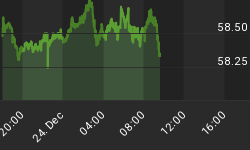Below is an extract from a commentary originally posted at www.speculative-investor.com on 18th March 2007.
The way we define the terms, there's a big difference between liquidity and money. This difference revolves around the fact that once money is borrowed into existence it remains in existence until/unless the debt is repaid*, whereas liquidity can disappear in an instant with no change in money supply. For example, the rate of US money supply growth hit a multi-decade high in late-2001 and remained at a well-above-average level throughout 2002, but by the second half of 2002 the financial markets were suffering from a massive loss of liquidity. The rapid growth of the US money supply during 2001-2002 and the rapid growth of the global money supply during 2003-2006 ultimately led to substantial liquidity within the financial markets, but the point is that high money-supply growth can co-exist with low market liquidity for an inconveniently long period (inconveniently long, that is, for those who hope that surging money-supply growth will bail them out of the leveraged speculations they entered during the preceding boom times).
Recently, investors in sub-prime mortgage debt have discovered how quickly liquidity can disappear once confidence takes a hit. At this stage the liquidity contraction has largely been confined to the sub-prime mortgage sector, but it could spread throughout the financial world. If it does then the pundits who claim that the recent high rates of money-supply growth all but guarantee rising asset prices over the next several months will be in for a big surprise.
In conjunction with our favourite yield-spread indicators, the combined performances of emerging market equities and debt should provide a timely signal that a sustained and widespread liquidity contraction -- as opposed to just a momentary restriction of liquidity in response to problems in one area -- is occurring. The reason is that the goings-on of the past few weeks suggest that the emerging markets theme is presently the focal point of speculation and is, therefore, amongst the most vulnerable of the many investment themes to a MAJOR change in the liquidity trend.
To be specific, if the financial world is going to experience more than a momentary loss of liquidity then what we should see over the coming month or so is substantial weakness in emerging market equities ALONGSIDE a substantial widening of emerging market credit spreads. With reference to the below chart, such an outcome would entail both EMD/USB ratio (the Emerging Markets Income Fund divided by the US Treasury Bond) and the EEM (an Emerging Market Equities ETF) moving to much lower levels. EEM and EMD/USB dropped between mid-February and early-March, but at this stage the declines look no worse than the other routine corrections that have occurred over the past few years.

At the same time as speculative bets on emerging market equities and debt are being exited en masse there should be a sharp rally in the Yen because the Yen carry trade has been such an important source of speculative financing and, therefore, liquidity. A Yen rally based on the unwinding of carry trades is, however, likely to be just a temporary phenomenon because as long as Japan's monetary authorities insist on keeping the official short-term interest rate close to zero there will be little chance of a major bull market in the Yen.
As things currently stand it is possible to make a reasonable case that we are witnessing the initial phase of a sustained liquidity contraction and resultant 1-2 year bear market in growth-oriented investments. But at the same time there are also signs that it could turn out to be just another shakeout within a continuing liquidity-driven bull market. After all, in order for a bull market to climb the proverbial "wall of worry" it is essential that worries be injected into the mix every now and then. In either case, though, the downturn is probably not yet over.
*Many people believe that debt defaults cause the supply of money to shrink, but this is not so. A debt default will probably reduce the wealth of the person/company making the loan, but if the loan originally resulted in new money being created -- for example, a loan made by a commercial bank to finance the purchase of a home -- then that money will have been spent by the debtor and will remain within the economy following the loan default. Of course, if the customers of a lender default on their loans then the ability and/or desire of that lender to make additional loans may be hampered. It is therefore possible for debt defaults to bring about a reduction in the future rate of money supply growth, but debt defaults do not directly affect the existing supply of money.















